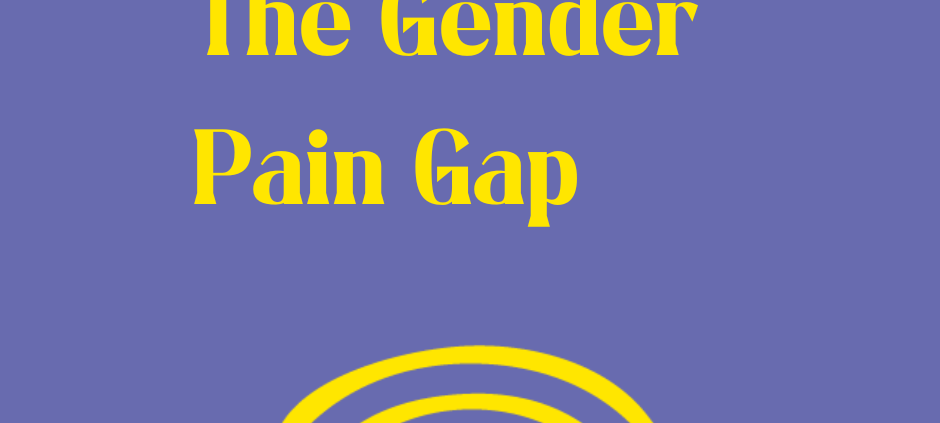Women’s pain is often undermined, with healthcare professionals believing that women are over-exaggerating their pain which results in women not receiving the correct pain medication. While the healthcare system is vital for everyone, it traditionally placed men as the default patient which has meant that there are more barriers for women. Research around healthcare also places more emphasis on men, which means that women’s voices are still not being heard or addressed. This is often referred to as the “Gender Pain Gap” and highlights the inefficiency of healthcare services and providers.
The gender pain gap has occurred due to several reasons. There are systemic failures within the healthcare system to provide women with the adequate treatment and care that they need, which is due to how the healthcare system placed men as the default patient and research around healthcare has predominantly focused on male voices. The healthcare system also has discriminatory attitudes, believing that women should have a higher pain tolerance due to childbirth, and therefore does not take women’s pain as serious as they would men’s. There have been cases in which women are receiving painkillers with a lower dosage when they report having the same pain as a man, with the man receiving a painkiller with a higher dosage, which emphasises how healthcare workers also enforce the gender pain gap, discriminatory attitudes, and all of this causes the systemic failure of healthcare to expand more. Women are dismissed and have their pain undermined, with views such as ‘it’s just a matter of life’ or ‘that’s a normal part of womanhood’. Recent research in the UK found that there are just under 30 million people living with chronic pain with around 70% being women, and yet women are more likely to be misdiagnosed in comparison to men.
Some examples of women being misdiagnosed include health conditions such as endometriosis which takes up to 8 years to be diagnosed in the UK and PCOS. As women are less likely to have their pain viewed as serious, it means they are also less likely to go to a healthcare professional. The long-term impacts of not receiving adequate health care have caused trouble with sleeping, unable to exercise and it impacts mental health including depression. In 2009 a woman was in A&E due to a high heart rate and chest pain and was told it was a panic attack. A few weeks after this, she went to her doctor due to pain and they told her “like a lot of women, I was paying too much attention to my body” and “to just relax and ignore the symptoms”. This continued over a 9 year period. While being misdiagnosed with anxiety, panic attacks and being told she was “confused”, she was then told she was experiencing heart attacks. The misdiagnosis of her condition arises due to a lack of research in how men and women experience heart attacks differently.
In the UK, a campaign was created by Nurofen. They named this campaign “See My Pain” which is a pledge that all pain is seen, irrespective of gender. They based this campaign on research they found, including that 1 in 2 women have had their pain dismissed by medical professions due to gender and 1 in 6 women experience severe pain every day. Nurofen made commitments around making women’s pain more visible including in research, products, healthcare, and in commissioning the index report which tracks the progress on closing the gender pain gap. This would allow for greater gender equality within the healthcare, as well as making sure health conditions such as endometriosis are analysed in research which then results in greater knowledge around women’s healthcare.
By listening to women’s experiences of healthcare and pain, it has allowed for a greater understanding of how severe the systemic discrimination against women and pain goes and highlights the need for change within the healthcare system. Nurofen then worked alongside McCann London to create the “Pain Pass” which is a downloadable, free PDF which allows for women to track their pain, and symptoms, which allows for more articulate conversations with their healthcare profession and tackles any bias. This PDF was created alongside healthcare professionals and women, and includes pain vocabulary, a pain scale, tips to help women have more confidence to advocate for themselves in interactions with healthcare professionals, and a calendar so women can track their pain. The PDF is available to download on Nurofen’s See My Pain website.
In England, a women’s healthcare strategy was created and implemented. This policy assumed an intersectional approach, and aims to address the different disparities that women face, ensuring that all voices are heard, supporting research which places a stronger focus on women’s voices, having better information and access to this information, and improving the access to the services. This policy in particular focuses on specific issues surrounding women’s healthcare, including menopause, menstruation, cancer, the health impacts of gender-based violence, pregnancy/fertility, mental health and healthy aging. A call for evidence resulted in just under 100,000 responses from women in England and just over 400 written responses from organisations and experts in the field of healthcare. The results of this found that around 84% of respondents were not listened to by healthcare professionals, and this was further exaggerated when the cases were related to pain. One of the examples given was how women and girls are told that painful, heavy periods are normal, and they will grow out of them. While that statistic may be shocking to some, it is the normal for women.
Women experience health conditions differently to men, including heart attacks, and due to the lack of research into how those conditions differ, it has resulted in health services becoming somewhat inefficient. By having campaigns such as See My Pain and having women’s healthcare strategies it is the start of addressing the gendered differences in healthcare. While these specific strategies and campaigns are happening in England, other countries need to consider creating policies and campaigns to ensure no woman is left behind in healthcare treatments, and they must take an intersectional approach to ensure that all women can experiences the correct healthcare.
By: Riley, WRDA Placement Student



